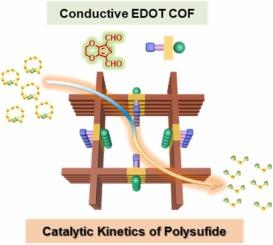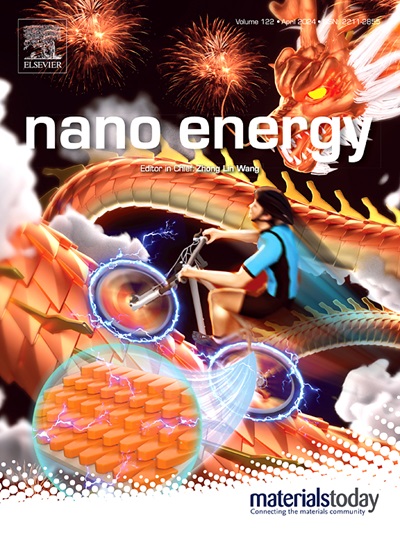具有导电EDOT单元的共价有机框架用于优质锂硫电池
IF 17.1
1区 材料科学
Q1 CHEMISTRY, PHYSICAL
引用次数: 0
摘要
3,4-乙烯二氧噻吩(EDOT)单元具有电子给体和自结构的特性,被认为是有机电子器件的导电聚合物资源。然而,用EDOT构建共价有机框架(COFs)尚未见报道。本文合成了一种新型导电的edot基COF (EDOT-Por-COF),该材料具有增强的化学相互作用和导电性,可作为加速可溶性多硫化物转化动力学的电催化剂。相应的具有富电子共轭微环境的EDOT-Por-COF具有更高的硫亲和性和多硫化物催化活性,实验数据和密度泛函理论(DFT)计算进一步验证了这一点。富电子环境的引入缓解了Co位点的电荷损失趋势,保证了Co位点周围的电子结构优化,从而提高了Co位点与多硫化物之间的吸附强度和电子转移,提高了对多硫化物的催化能力。结果表明,该电池在0.1℃下具有1585.9 mAh g−1的超高放电容量,在1℃下循环2000次,每循环容量衰减率低至0.031%,在5℃下具有763.9 mAh g−1的高倍率容量。这项工作为电催化剂结构调节提高锂硫电池的电化学性能提供了新的见解。本文章由计算机程序翻译,如有差异,请以英文原文为准。

Covalent organic frameworks with conductive EDOT unit for superior lithium−sulfur batteries
3,4-ethylenedioxythiophene (EDOT) unit featuring electron donor and self-structuring properties, has been considered as the conducting polymers resources for organic electronic devices. However, construction of covalent organic frameworks (COFs) with EDOT building blocks has not been reported. Herein, a novel conductive EDOT-based COF (EDOT-Por-COF) with enhanced chemical interaction and conductivity was synthesized as the electrocatalysts accelerating the conversion kinetics of soluble polysulfides. The corresponding EDOT-Por-COF with electron-rich conjugated microenvironment generates higher sulfur affinity and polysulfides catalytic activity, which is further verified by experimental data and density functional theory (DFT) calculations. The introduction of an electron-rich surrounding environment alleviates the tendency of charge loss at Co sites and guarantees an optimized electronic structure around the Co sites, thus improving the adsorption strength and electron transfer between the Co sites and polysulfides, contributing to an improved catalytic capability on polysulfides. As a result, the assembled cell displays a ultrahigh discharge capacity of 1585.9 mAh g−1 at 0.1 C, a low the capacity decay rate of 0.031 % per cycle for 2000 cycles at 1 C and a high rate capacity of 763.9 mAh g−1 at 5 C. This work supports a new insight into electrocatalyst structural regulation to boost the electrochemical performance of Li–S batteries.
求助全文
通过发布文献求助,成功后即可免费获取论文全文。
去求助
来源期刊

Nano Energy
CHEMISTRY, PHYSICAL-NANOSCIENCE & NANOTECHNOLOGY
CiteScore
30.30
自引率
7.40%
发文量
1207
审稿时长
23 days
期刊介绍:
Nano Energy is a multidisciplinary, rapid-publication forum of original peer-reviewed contributions on the science and engineering of nanomaterials and nanodevices used in all forms of energy harvesting, conversion, storage, utilization and policy. Through its mixture of articles, reviews, communications, research news, and information on key developments, Nano Energy provides a comprehensive coverage of this exciting and dynamic field which joins nanoscience and nanotechnology with energy science. The journal is relevant to all those who are interested in nanomaterials solutions to the energy problem.
Nano Energy publishes original experimental and theoretical research on all aspects of energy-related research which utilizes nanomaterials and nanotechnology. Manuscripts of four types are considered: review articles which inform readers of the latest research and advances in energy science; rapid communications which feature exciting research breakthroughs in the field; full-length articles which report comprehensive research developments; and news and opinions which comment on topical issues or express views on the developments in related fields.
 求助内容:
求助内容: 应助结果提醒方式:
应助结果提醒方式:


